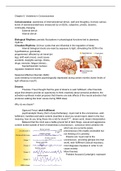Class notes
Chapter 5: Variations in Consciousness
- Institution
- Carleton University (CU )
Notes for the fifth chapter of the textbook Weiten, W. & McCann, D. (2019). Psychology: Themes and Variations. Fifth Canadian Edition. Nelson Education Ltd. as well as lecture notes for variations in consciousness.
[Show more]



